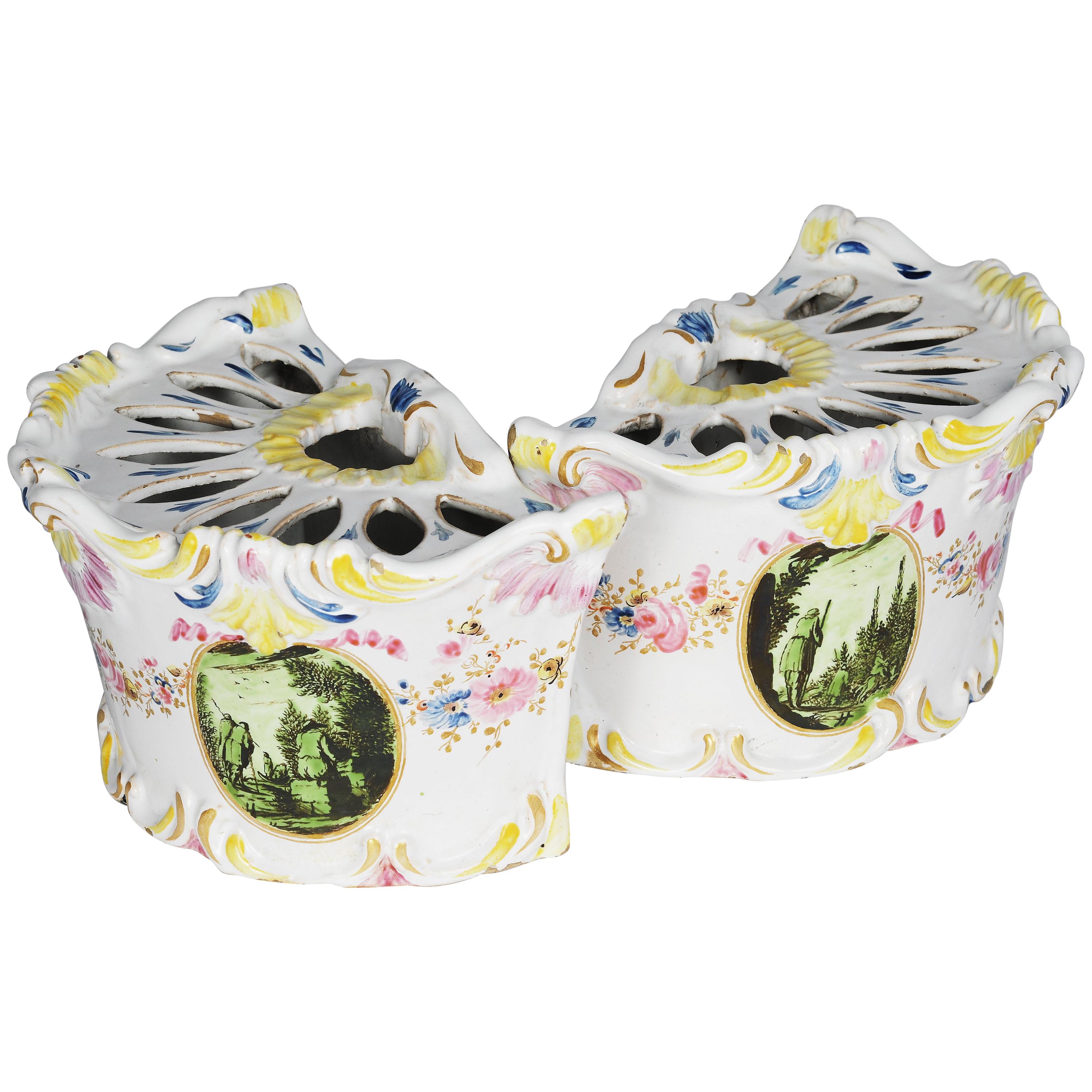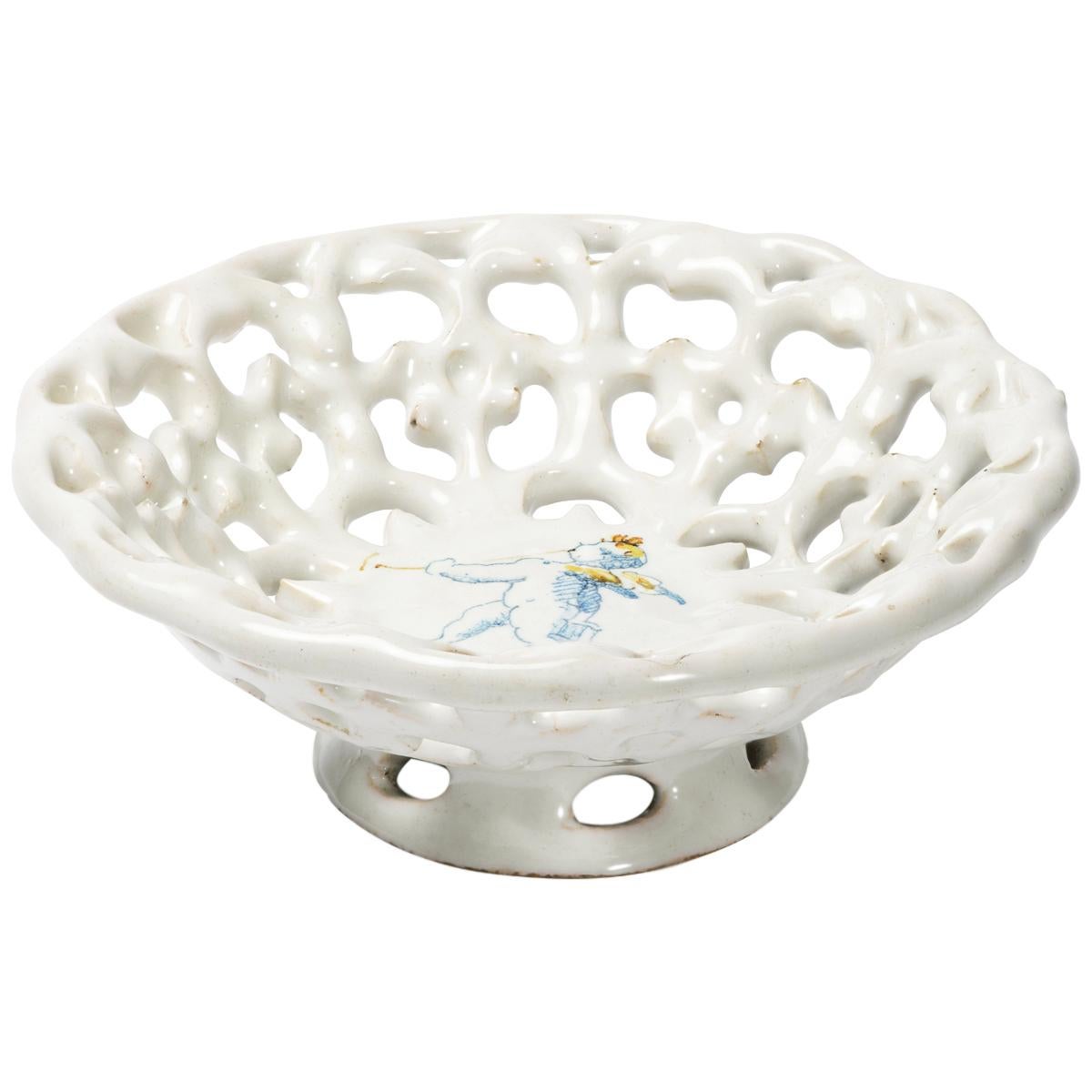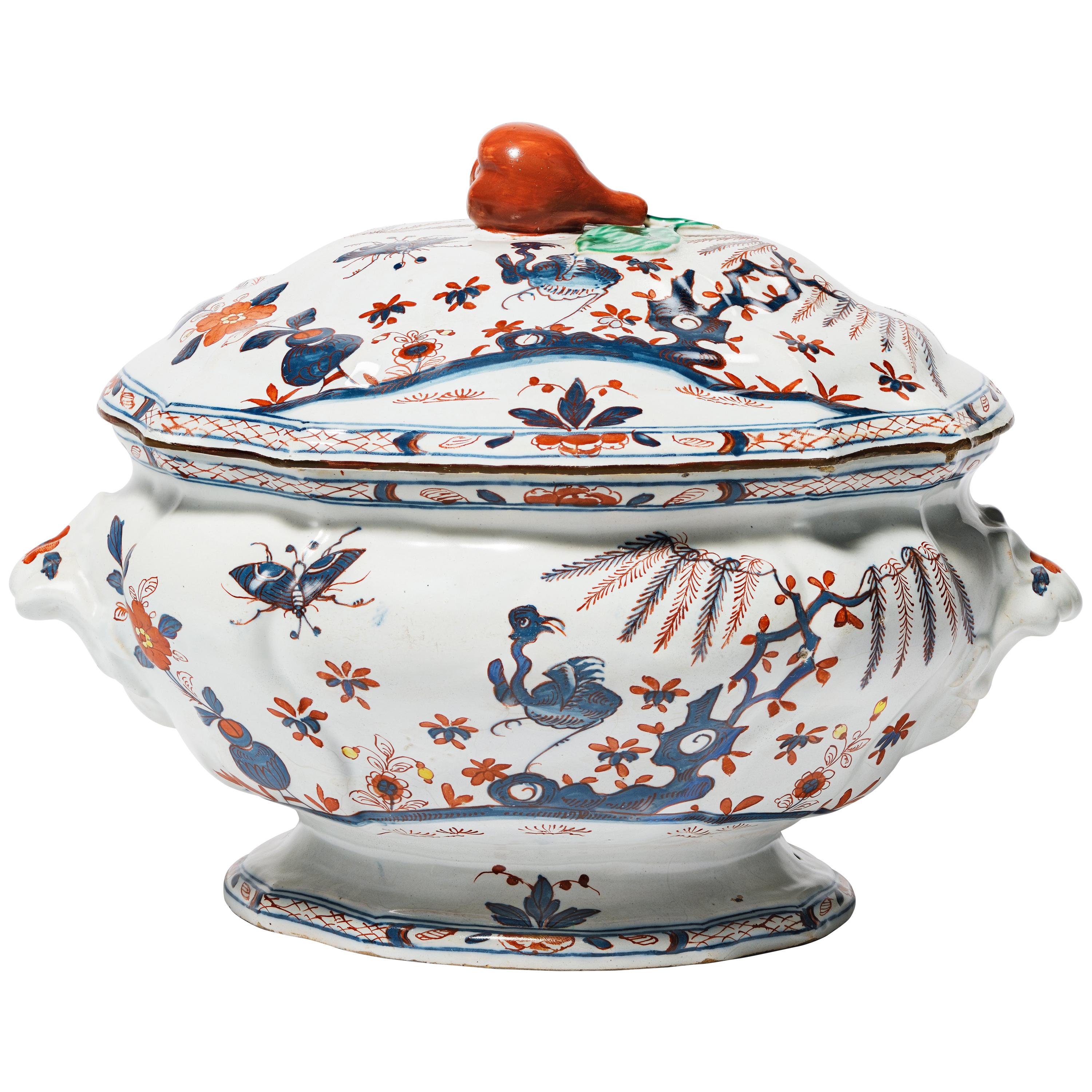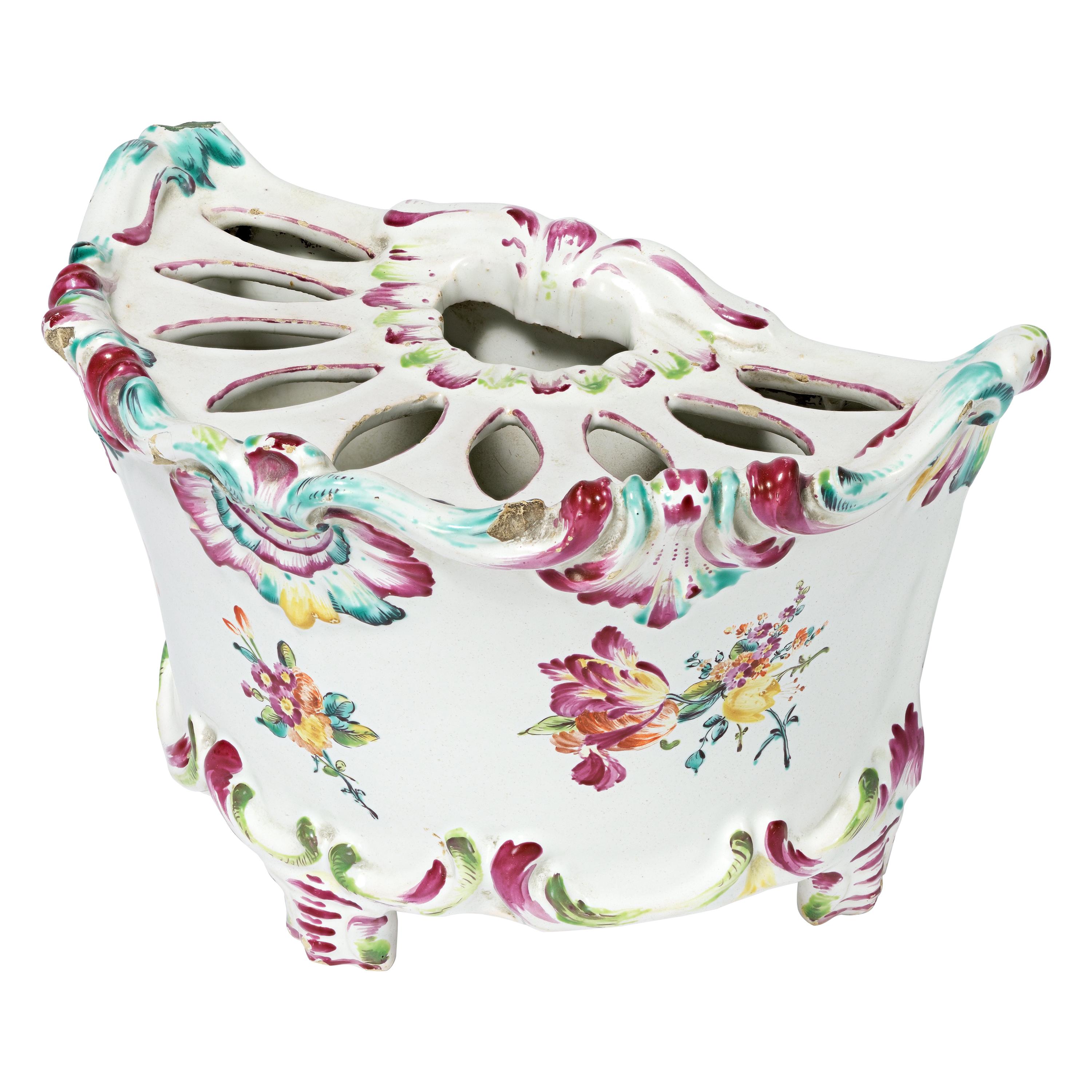Items Similar to Ancient Italian Maiolica Faenza, Ferniani Factory, Circa 1700
Video Loading
Want more images or videos?
Request additional images or videos from the seller
1 of 18
Ancient Italian Maiolica Faenza, Ferniani Factory, Circa 1700
About the Item
Centerpiece white maiolica shell
Ferniani factory, early period: 1693-1776
Faenza, circa 1700
Measures: 5.6 in x 14.72 in x 13.46 in (14.3 cm x 37.4 cm x cm 34.2)
lb 4.4 each (kg 2)
State of conservation: mimetic restoration on the front and conservative restoration on the back, few additions.
The Conti Ferniani factory is considered to be the oldest and longest lasting manufacturing of the Emilia-Romagna region: it remained active for two centuries and took a leading role in Faenza production, so much so that it was to become, during the 18th century and in the subsequent period, a symbol of "inseparable and extraordinary binomial Faenza-Ferniani" (Ravanelli Guidotti Carmen, a cura di, “La Fabbrica Ferniani. Ceramiche faentine dal barocco all’eclettismo”, Milano 2009, p.19).
This maiolica centerpiece is a rare example of the continuation of the fashion of the "Bianchi" Faenza into the 18th century: it is a decorative style known as "compendiaria maniera", a kind typical of the 16th century that brought about a real change in taste in the production of maiolica and that used only a few colors (yellow, blue and brown) in the creation of the decorations.
The shell model, with its fan-shaped grooves, wavy edge and base adorned with rococo-style curves, comes from the oldest production and is in this example decorated with a simple pattern called "a peducci", on a white-enameled bottom. This pattern took its roots in earlier forms, such as in the motifs called “a merletto” (“lace motif”) in 17th century. Some examples of this decoration are published in Ravanelli Guidotti, Carmen. Thesaurus di opere della tradizione di Faenza. Faenza 1998 pp. 553-565, all datable to the beginning of the century.
The decoration, which is concentrated only along the edge, is intentionally used to enhance the shape of the object. An indicative comparison is published in S. Levy, Maioliche romagnole, marchigiane, toscane; Maiolica italiana del XVIII, Milano 1970, tav. 178.
Some examples with different decorations are known. Among these are exemplary compendiari with emblems or works with the most complex decorations, such as the splendid shell placed on the antiquarian market and decorated in polychrome by the painter of 1740 (Ravanelli Guidotti Carmen”, a cura di “La Fabbrica Ferniani. Ceramiche faentine dal barocco all’eclettismo, Milano 2009, p. 165, n. 5).
- Creator:Ferniani Factory (Manufacturer)
- Dimensions:Height: 5.63 in (14.3 cm)Width: 13.47 in (34.2 cm)Depth: 14.73 in (37.4 cm)
- Style:Baroque (Of the Period)
- Materials and Techniques:Maiolica,Other
- Place of Origin:
- Period:1700-1709
- Date of Manufacture:circa 1700
- Condition:Repaired: Mimetic restoration on the front and conservative restoration on the back, few additions. Wear consistent with age and use. Mimetic restoration on the front and conservative restoration on the back, few additions.
- Seller Location:Milano, IT
- Reference Number:1stDibs: LU4352214023792
About the Seller
4.3
Vetted Seller
These experienced sellers undergo a comprehensive evaluation by our team of in-house experts.
Established in 1860
1stDibs seller since 2018
19 sales on 1stDibs
Typical response time: 4 hours
Associations
International Confederation of Art and Antique Dealers' Associations
- ShippingRetrieving quote...Ships From: Milano, Italy
- Return PolicyA return for this item may be initiated within 14 days of delivery.
More From This SellerView All
- Ancient Italian Maiolica Faenza, Ferniani Factory, Circa 1700By Ferniani FactoryLocated in Milano, ITCenterpiece light blue maiolica shell Ferniani factory, early period: 1693-1776 Faenza, 1700 circa 5.5 in x 14.72 in x 13.77 in (14 cm x 37.4 cm X cm 35) lb 4.40 (kg 2) State of con...Category
Antique Early 1700s Italian Baroque Ceramics
MaterialsMaiolica
- Pair of Ancient Italian Maiolica Flower Pots Milan, Rubati Factory, 1770 circaBy Pasquale RubatiLocated in Milano, ITMaiolica flower pot “a mezzaluna” decorated with trompe l’oeil Pasquale Rubati Factory Milan, circa 1770 Measures: each 4.7 in (cm 12) x 5 in (c...Category
Antique 1770s Italian Rococo Ceramics
MaterialsMaiolica
- Ancient Italian Renaissance Maiolica Crespina, Faenza, 1580 CircaLocated in Milano, ITCrespina Faenza, last quarter of the 16th century Maiolica painted in two colors, light blue and yellow, on a thick, rich layer of white enamel. It measures 2.24 in (5.7 cm) in height, 6.10 in (15.5 cm) in diameter. lb 0.55 (kg 0.25) State of conservation: mimetic restoration. The small cup has a raised central “umbone”, a perforated brim and a shaped rim. It rests on a high jutting foot. The "crespina" shape, in some inventories is cited as "tacce de frute" (fruit cups). It was particularly appreciated in the Renaissance and has variants based on the formal types and the different sizes. The decoration, made according to the dictates of the “compendiario” style, used few standardized colors: blue and yellow on a thick white and shiny enamel, deliberately chosen as the colour which was most reminiscent of silver. This choice derived from a trend in creative design of the era: the shapes used in the molds were often taken from metal objects. An idea which would last throughout the Renaissance. The work shows, in the middle of the “umbone”, a winged putto stepping forward while playing a long thin trumpet. The depiction of the putto is fully representative of the repertoire of the Faenza workshops of the sixteenth century. Some specimens with this type of decoration have been published in a volume by Carmen Ravanelli Guidotti: there appears the whole productive repertoire of this fundamental moment of transition between the taste for the “istoriato” style and the great simplification of decoration in the “compendiario” period. This style, in its simplicity, however, saw its expression in a rather varied collection of decorative subjects, including old-fashioned busts...Category
Antique 16th Century Italian Renaissance Ceramics
MaterialsMaiolica
- Ancient Maiolica Flower Pot Pasquale Rubati Factory, Milan Circa 1770By Pasquale RubatiLocated in Milano, ITMaiolica flower pot “a mezzaluna” decorated with tulip Pasquale Rubati Factory Milan, circa 1770. Measures: 4.7 in x 4.7 in x 8.6 in 12 cm x 12...Category
Antique 1770s Italian Rococo Ceramics
MaterialsMaiolica
- Ancient Italian Maiolica Tureen Milano, 1770 circaBy Pasquale Rubati, Felice ClericiLocated in Milano, ITMaiolica tureen “allo struzzo” (ostrich decoration) Milan, Felice Clerici or Pasquale Rubati factory, circa 1750-1780 Measures: 9.25 in x 12.79 in x 10.23 in (cm 23.5 x cm 32.5 x cm 26) lb 4.78 (kg 2.17) State of conservation, a felûre consolidated inside with slight edge chipping restored. In Milan in the 18th century two Majolica warehouses were opened, the first, by Felice Clerici, in 1745, the second in 1756 by Pasquale Rubati. Traditionally this type of decoration has been attributed to the Pasquale Rubati factory. In reality the motif “allo struzzo”, one of the clearest examples of how the taste for chinoiserie met with considerable success during the 18th century, had been produced, in specimens of greater or lesser quality, by both Milanese manufactories. This Maiolica tureen has a swollen and ribbed oval bowl, rests on an extroflexed foot and shows stirrup handles. The tri-color ornament, in the typical tones of Japanese "Imari" decorations, shows an idealized oriental landscape that develops around a perforated rock and has a willow tree with long lance-shaped leaves framing the long-legged bird figure. The ornamentation is enhanced by decorative elements such as butterflies, small florets and a vase with a thin flowery stem. The lid is ribbed with a pear-shaped knob on top. The decoration was called in the Milanese manufactories "allo struzzo" (ostrich decoration) and this refers to the oriental figure Xian He or the crane, symbol of longevity, here losing its symbolic value. It is hypothesized that among some 16th century engravings...Category
Antique 1770s Italian Chinoiserie Ceramics
MaterialsMaiolica
- Rococo Italian Maiolica Flower Pot Pasquale Rubati, Milano, 1770 circaBy Pasquale RubatiLocated in Milano, ITMaiolica flower pot “a mezzaluna” with support feet decorated with little bunches of flowers Pasquale Rubati Factory Milan, circa 1770 5.5 in X ...Category
Antique 1770s Italian Rococo Ceramics
MaterialsMaiolica
You May Also Like
- Antique Italian Maiolica Classical Painted Vase 19th CenturyLocated in Bishop's Stortford, HertfordshireA stunning and rare antique Italian Maiolica pottery triple gourd vase hand-painted with classical stylised figurative and scroll designs in typical ...Category
Antique 19th Century Italian Vases
MaterialsMaiolica, Pottery
- Antique Italian Maiolica Portrait Painted Pottery Vase, 19th CenturyLocated in Bishop's Stortford, HertfordshireA stunning and rare antique Italian Maiolica pottery triple gourd vase hand-painted with portraits set amidst classical and scroll designs in typical...Category
Antique 19th Century Italian Vases
MaterialsMaiolica, Pottery
- "Trottola", wheeled ceramic vase, black and light blue glaze, Gatti 1928 FaenzaBy Ceramica Gatti 1928, Andrea AnastasioLocated in Faenza, ITVaso grande in ceramica elegante. Centrotavola colore azzurro e nero . Le Trottole sono vasi di medio-grande dimensione, che evocano il mondo ludico e le forme...Category
2010s Italian Modern Ceramics
MaterialsCeramic
- Large Art Deco Ceramic by Jaget Et Pinon Factory in Tours, circa 1930By Pinon HeuzeLocated in Mouscron, WHTJAGET ET PINON factory in Tours. Baluster vase with long necks and three handles in brown enamelled earthenware with gilt and copper decoration amid pl...Category
Vintage 1930s French Art Deco Vases
MaterialsCeramic
- 18th Century Ancient Faenza Pharmacy Jar Full PaintedLocated in PALERMO, ITPharmacy jug. Faenza, Italy. Majolica painted in blue monochrome, on a blue enameled background called berettino and tints of tin white.Category
Antique 18th Century Italian Ceramics
MaterialsMajolica
- Ceramic Vase, Italy, circa 1950sBy Giovanni de SimoneLocated in San Diego, CABeautiful midcentury hand painted ceramic vase. Italy, circa 1950s.Category
Vintage 1950s Italian Mid-Century Modern Ceramics
MaterialsCeramic
Recently Viewed
View AllMore Ways To Browse
The Antique Factory
Italian Ceramics Brown
Antique Glass Restoration
Antique Silver Symbols
Circa 1700s
Antique Glass Symbols
Antique Symbols On Silver
Antique Wavy Glass
Blue And White Italian Ceramics
18th Century Fan
Real Shell
Antique Style Fan
Antique Style Fans
Rococo Shell Motif
16th Century Baroque
Model 165
Milano Antique
Faenza Ceramics





